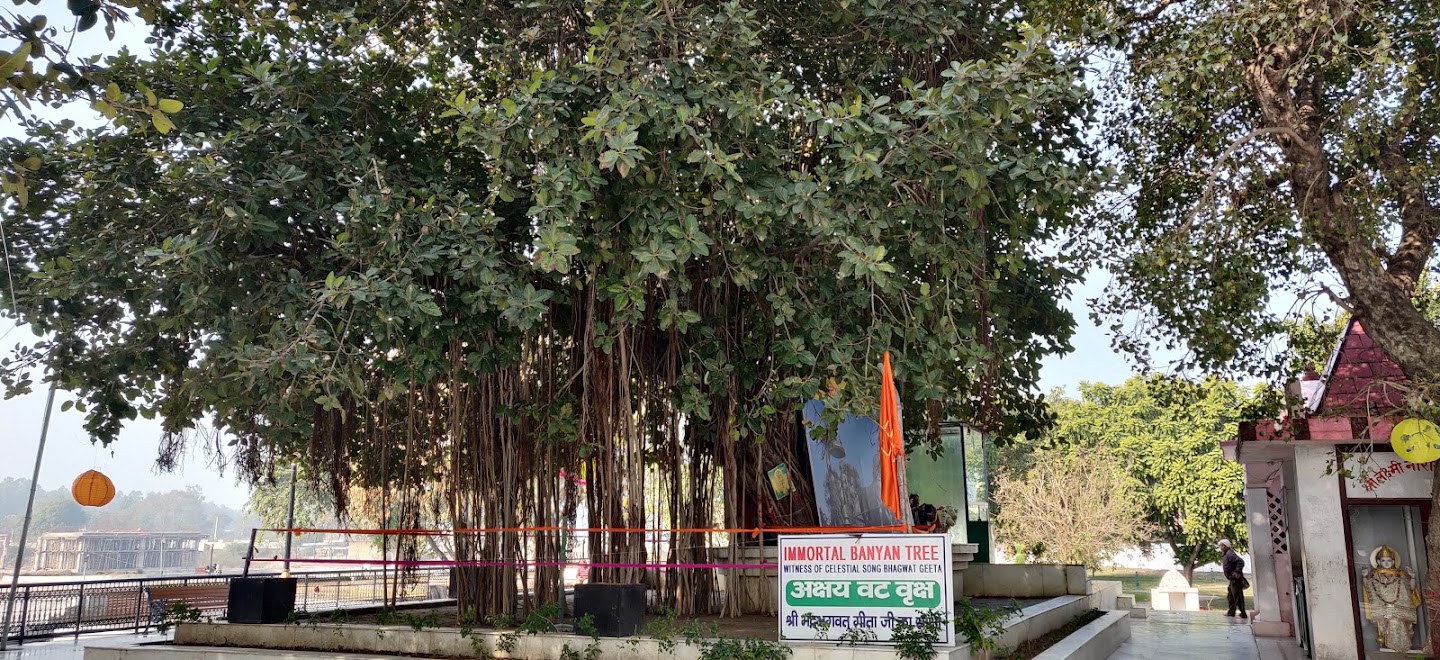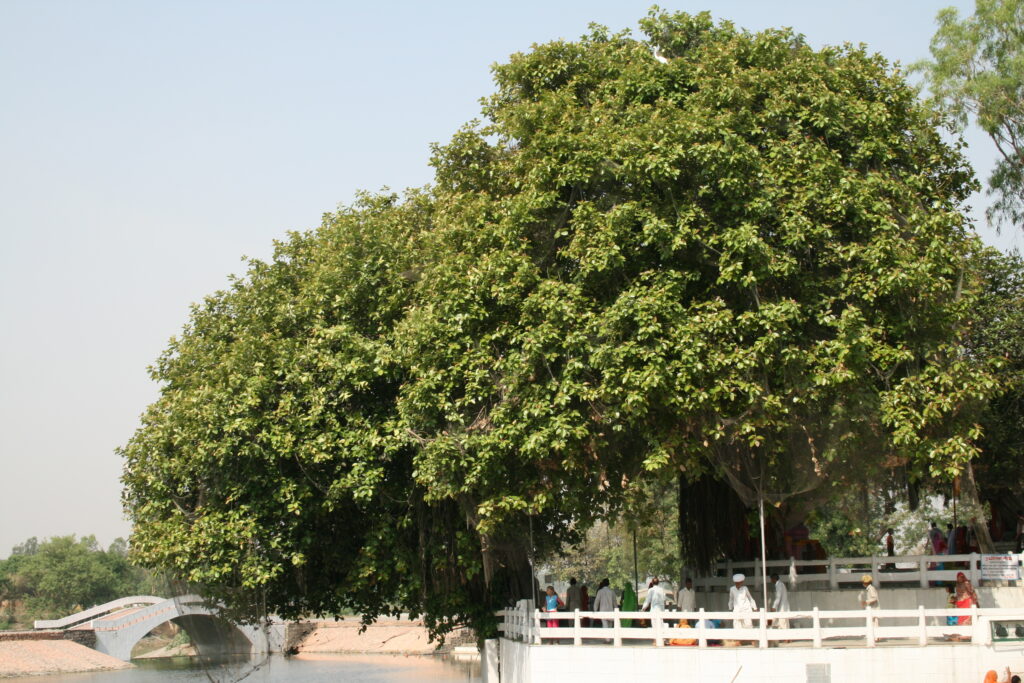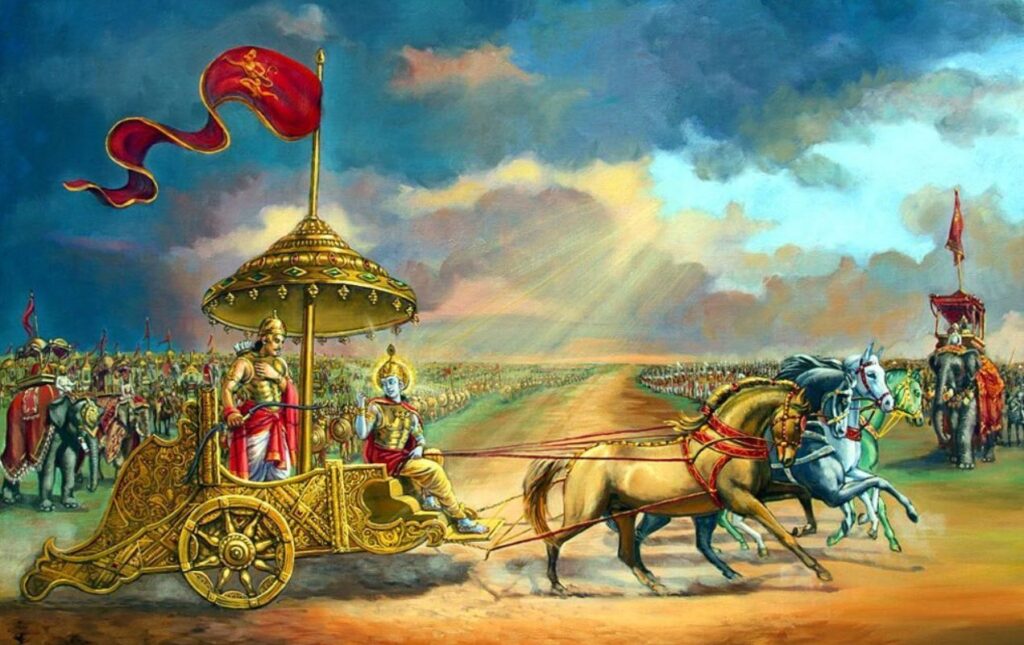
Jyotisar in Kurukshetra is the sacred spot where Lord Krishna spoke the Bhagavad Gita to His intimate friend and devotee Arjuna. It is said that the Bhagavad Gita was spoken under a banyan tree known as the Akshaya Vata. In Jyotisar, this Akshaya Vata has been marked with a huge board as the ‘Gitopadesha Sthala’ to differentiate it from other banyan trees in the vicinity which is said to have grown from the seeds and shoots of this Akshaya Vata.
It is located on the banks of Jyotisar Sarovar in the sacred town of Kurukshetra in Haryana state of India. Kurukshetra has been an extremely sacred land far before the Mahabharata war. That is why Lord Krishna chose this place specifically in order to favor dharmic members in the war.

Gita Jayanthi is the day when Lord Krishna spoke Bhagavad-gita to Arjuna. It is celebrated grandly here every year on the Shukla Ekadashi (11th day of waxing moon) of the Margashirsha month. The Gita Deepotsav is also celebrated here grandly by lighting thousands of lamps on the banks of the Brahma Sarovar, Sannihit Sarovar and the Jyotisar Sarovar nearby. Three lakh lamps were lit here in December 2020.
The very word jyotisar is formed from two words i.e. jyoti and sar. Jyoti implies light of knowledge of Vedas while sar implies essence. Literally implying ‘The essence of knowledge’. Bhagavad-gita is the essence of the teachings of the Vedas, Upanishads, Puranas, etc. These teachings bring spiritual light into a human being’s life. Hence, the place where it was spoken came to be known as Jyotisar. The Haryana state tourism department showcases the lila here every evening through a light and sound show.
History of Jyotisar
The history of Jyotisar is integrated with that of Kurukshetra which was found by King Kuru. When Lord Krishna was ruling over Dwaraka in the Dwapara-yuga, there were two major families i.e. Kauravas and Pandavas. The Kauravas under King Dhritarashtra and his son Duryodhana were neglectful of dharma while the Pandavas headed by Yudhisthira were very righteous and under the protection of Lord Krishna.
The Pandavas were exiled after losing a game of dice and being humiliated after the disrobing of their wife Draupadi Devi by the Kauravas. During their exile, the Kauravas especially Duryodhana made many attempts to kill the Pandavas but were protected by the mercy of Lord Krishna. At the end of their exile, they went and asked the Kauravas for their share in the administration of the Kingdom.

Being Kshatriyas, they pleaded that they should get at least five villages for each of the Pancha Pandavas to rule. But they were insulted by Duryodhana saying that they would not get land to even place a needle. This set the stage for the Mahabharata war. Lord Krishna Himself took up the task to diffuse the situation by acting as a mediator but the Kauravas would not relent.
Now that the war was inevitable, Lord Krishna asked Duryodhana to choose between Him (Krishna) and Krishna’s Army. Thinking that Lord Krishna’s army would add to his strength, Duryodhana selected the same. Thus, the Pandavas had the personal guidance of Lord Krishna who also became the charioteer of Arjuna. The war was to be fought on the sacred land of Kurukshetra.
Lord Krishna speaks Bhagavad-gita in Kurukshetra
On the first day of the war, Arjuna asked Lord Krishna to bring the chariot to the middle of the battlefield so as to see the people who were going to fight against him. After doing so, Arjuna was bewildered and morose to see his friends and relatives all assembled on the battlefield of Kurukshetra ready to fight each other. In such a state, Arjuna decided to withdraw from the battlefield out of his compassionate nature.
Seeing this condition of Arjuna, Lord Krishna spoke Bhagavad-gita. After covering various topics about the jiva, atma, paramatma, kala, karma, etc., in 700 shlokas, Arjuna was no longer morose. He decided to fight the war which resulted in the victory of the Pandavas.
The Bhagavad-gita was instructed under a banyan tree called as Akshaya Vata. The Virata Rupa of Lord Krishna was also revealed here. Later, this place came to known as Jyotisar as enlightening knowledge was revealed here.
Jyotisar Years Later
In the Ninth century, Adi Shankaracharya had identified Jyotisar as the very place where Lord Krishna instructed Arjuna in the Bhagavad-gita under the Akshaya Vata. In 1850 CE, the King of Kashmir had constructed a temple dedicated to Lord Shiva at the tirtha. In 1924, the King of Darbhanga had built a stone wall around the Akshaya Vata tree.
In 1967, H.H. Shankaracharya of the Kanchi Kamakoti Peetha had installed a marble figure depicting the Gita Upadesha lila of Lord Krishna in a glass box.
Best time to visit Jyotisar
The best time visit Jyotisar is to from August to April. Festivals like Gita Jayanti and Karthika Utsava are generally very crowded.
How to Reach Jyotisar
To avoid any hazzles and to get a better spiritual experience, better book Vrindavana Tour in which Kurukshetra is covered exclusively.
Being located in Kurukshetra, you have to reach Kurukshetra first to visit Jyotisar. There are ample means to reach Kurukshetra by road, rail and air. Let us take a look at them –
By Road: Kurukshetra is well-connected by road to cities in Haryana such as Ambala (51 km), Karnal (40 km), etc., and major cities in India such as New Delhi (166 km), Chandigarh (101 km), etc. Haryana Roadways and other state corporation buses run services between Kurukshetra and all these cities. In fact, Kurukshetra is connected to New Delhi via NH1, the oldest national highway of India popularly known as Grand Trunk road at the Pipli road junction.
Taxi services are available from these cities too.
By Rail: Kurukshetra Junction (KKDE) Railway Station connects Kurukshetra to the other parts of India. Trains from major cities of India halt here.
By Air: For domestic passengers, Chandigarh International Airport (96 km) is the nearest airport followed by Hisar Airport (172 km). The IGI Airport (183 km) at New Delhi is the nearest international airport. Though the airport at Chandigarh serves two international destinations. You can fly into these airports and take the rail or road route to reach Kurukshetra.
4










4 Comments On Jyotisar
Rajagopalan
Excellent coverage about jyotsar
Ragni
Great and clear content , very useful information.
Hare Krishna
Raj Melwani
My reverence to you for sharing and updating my faith in Hinduism. Pranams.
Uma Nagesh
I wholeheartedly thank Tirtha yatra for enlightening with such good information